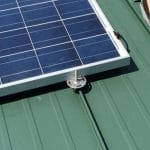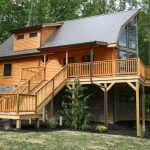Energy efficiency and log cabin sustainability work together to save the environment as well as money. Here a just a few solutions for keeping your log cabin green. Also, don’t forget to check out our log cabin sustainability infographic at the bottom of the post!
Log Cabin Sustainability Starts With the Logs
If you’re considering purchasing a log cabin kit and care about the environment, you’ll want to start  with a kit company known for sustainable practices. Logs by their very nature are a sustainable resource. However, certain harvesting processes take less of a toll on the environment than others. Conestoga Log Cabins only uses logs from planted forests. This means that natural forests can be preserved and deforestation is decreased. In addition all of Conestoga’s logs come from certified Forest Stewardship Council (FSC) suppliers.
with a kit company known for sustainable practices. Logs by their very nature are a sustainable resource. However, certain harvesting processes take less of a toll on the environment than others. Conestoga Log Cabins only uses logs from planted forests. This means that natural forests can be preserved and deforestation is decreased. In addition all of Conestoga’s logs come from certified Forest Stewardship Council (FSC) suppliers.
A responsible log cabin manufacturer will not just use logs from planted forests but will also use manufacturing techniques that significantly reduce waste. Conestoga’s state-of-the-art manufacturing facility employs the latest technology when cutting logs. No part of the logs goes to waste! Even better, a local farmer uses the extra wood shavings for animal bedding.
The Sun: Free Energy
 Most log homes are temperature controlled using natural gas, oil or coal, all of which are costly, contribute to pollution and are in diminishing supply. The sun can provide a free natural energy source. You can start by considering the position of your log cabin before you build. Design and orient the house to minimize summer afternoon solar heat gain and optimize winter solar heat gain. In the northern hemisphere, this means orienting the long sides of the house to face south and north and creating roof overhangs and landscaping that shade the east, south, and west sides of the house. Situate the house to take advantage of prevailing breezes during the spring, summer, and fall. Not only are these breezes valuable for cross-ventilation in the cabin, but they can make screened-in rooms and porches more comfortable places to live (National Building Museum). You can take it one step further and install solar panels. They turn the sun’s heat into energy.
Most log homes are temperature controlled using natural gas, oil or coal, all of which are costly, contribute to pollution and are in diminishing supply. The sun can provide a free natural energy source. You can start by considering the position of your log cabin before you build. Design and orient the house to minimize summer afternoon solar heat gain and optimize winter solar heat gain. In the northern hemisphere, this means orienting the long sides of the house to face south and north and creating roof overhangs and landscaping that shade the east, south, and west sides of the house. Situate the house to take advantage of prevailing breezes during the spring, summer, and fall. Not only are these breezes valuable for cross-ventilation in the cabin, but they can make screened-in rooms and porches more comfortable places to live (National Building Museum). You can take it one step further and install solar panels. They turn the sun’s heat into energy.
Windows
Conestoga uses Low E Argon windows which limit the amount of heat that passes through windows without reducing light in the summer and keep heat inside during the winter.
Landscaping
When you picture a log cabin, it is probably surrounded by trees.  This scene is not only beautiful, but beneficial. Shade trees can keep your cabin cooler in the summer but sunlight can still get through the bare branches in the winter to warm your cabin. Shading your cabin’s roof can increase the air conditioner’s energy efficiency by more than 10%.
This scene is not only beautiful, but beneficial. Shade trees can keep your cabin cooler in the summer but sunlight can still get through the bare branches in the winter to warm your cabin. Shading your cabin’s roof can increase the air conditioner’s energy efficiency by more than 10%.
Metal roofs
Metal roofs not only compliment a cabin, but are a sound environmentally friendly choice in terns of log cabin sustainability. The

Metal Roof
longevity of metal roofs is significantly longer than traditional asphalt shingles. Even though metal roofs are more expensive at the onset, the overall life cycle cost is lower because they can last up to 50 years or more. They are also 100% recyclable! On top of that, they offer energy savings of up to 40% depending on the roof color and cabin location.
Saving Electricity and Money
Whether your log cabin is a new build or it’s just time to start replacing appliances, consider how much energy they consume. Look for appliances that are ENERGY STAR certified.
Don’t underestimate the impact of your light bulb choice. The average household uses 5% of its energy budget on lighting. By converting to LED lights, you save electricity and money while keeping your log cabin green.
For more on log cabin sustainability, read our Rainwater Harvesting Blog to learn how to collect water for your use.

